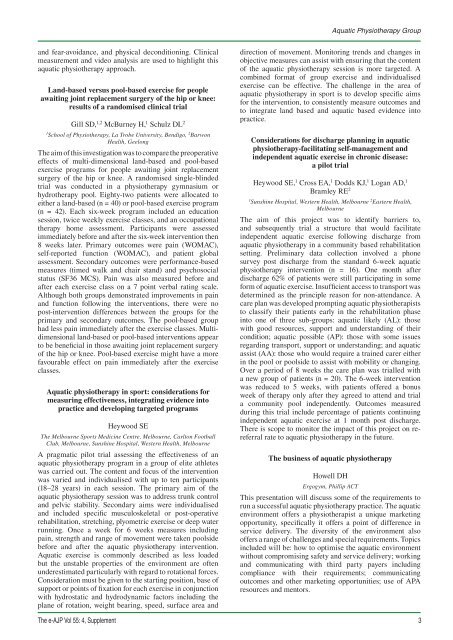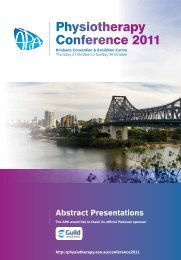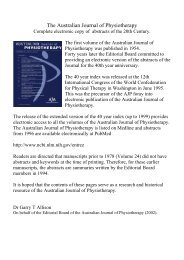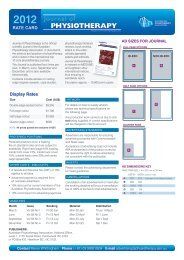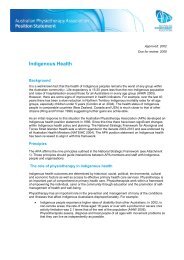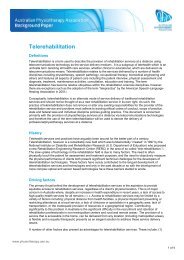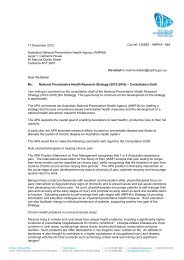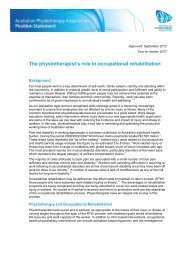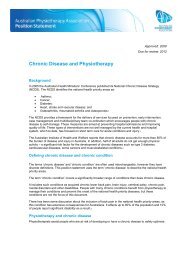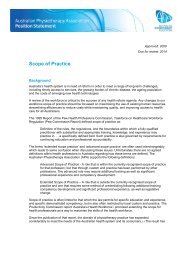2009 APA Conference Week Abstracts - Australian Physiotherapy ...
2009 APA Conference Week Abstracts - Australian Physiotherapy ...
2009 APA Conference Week Abstracts - Australian Physiotherapy ...
You also want an ePaper? Increase the reach of your titles
YUMPU automatically turns print PDFs into web optimized ePapers that Google loves.
Aquatic <strong>Physiotherapy</strong> Group<br />
and fear-avoidance, and physical deconditioning. Clinical<br />
measurement and video analysis are used to highlight this<br />
aquatic physiotherapy approach.<br />
Land-based versus pool-based exercise for people<br />
awaiting joint replacement surgery of the hip or knee:<br />
results of a randomised clinical trial<br />
Gill SD, 1,2 McBurney H, 1 Schulz DL 2<br />
1<br />
School of <strong>Physiotherapy</strong>, La Trobe University, Bendigo, 2 Barwon<br />
Health, Geelong<br />
The aim of this investigation was to compare the preoperative<br />
effects of multi-dimensional land-based and pool-based<br />
exercise programs for people awaiting joint replacement<br />
surgery of the hip or knee. A randomised single-blinded<br />
trial was conducted in a physiotherapy gymnasium or<br />
hydrotherapy pool. Eighty-two patients were allocated to<br />
either a land-based (n = 40) or pool-based exercise program<br />
(n = 42). Each six-week program included an education<br />
session, twice weekly exercise classes, and an occupational<br />
therapy home assessment. Participants were assessed<br />
immediately before and after the six-week intervention then<br />
8 weeks later. Primary outcomes were pain (WOMAC),<br />
self-reported function (WOMAC), and patient global<br />
assessment. Secondary outcomes were performance-based<br />
measures (timed walk and chair stand) and psychosocial<br />
status (SF36 MCS). Pain was also measured before and<br />
after each exercise class on a 7 point verbal rating scale.<br />
Although both groups demonstrated improvements in pain<br />
and function following the interventions, there were no<br />
post-intervention differences between the groups for the<br />
primary and secondary outcomes. The pool-based group<br />
had less pain immediately after the exercise classes. Multidimensional<br />
land-based or pool-based interventions appear<br />
to be beneficial in those awaiting joint replacement surgery<br />
of the hip or knee. Pool-based exercise might have a more<br />
favourable effect on pain immediately after the exercise<br />
classes.<br />
Aquatic physiotherapy in sport: considerations for<br />
measuring effectiveness, integrating evidence into<br />
practice and developing targeted programs<br />
Heywood SE<br />
The Melbourne Sports Medicine Centre, Melbourne, Carlton Football<br />
Club, Melbourne, Sunshine Hospital, Western Health, Melbourne<br />
A pragmatic pilot trial assessing the effectiveness of an<br />
aquatic physiotherapy program in a group of elite athletes<br />
was carried out. The content and focus of the intervention<br />
was varied and individualised with up to ten participants<br />
(18–28 years) in each session. The primary aim of the<br />
aquatic physiotherapy session was to address trunk control<br />
and pelvic stability. Secondary aims were individualised<br />
and included specific musculoskeletal or post-operative<br />
rehabilitation, stretching, plyometric exercise or deep water<br />
running. Once a week for 6 weeks measures including<br />
pain, strength and range of movement were taken poolside<br />
before and after the aquatic physiotherapy intervention.<br />
Aquatic exercise is commonly described as less loaded<br />
but the unstable properties of the environment are often<br />
underestimated particularly with regard to rotational forces.<br />
Consideration must be given to the starting position, base of<br />
support or points of fixation for each exercise in conjunction<br />
with hydrostatic and hydrodynamic factors including the<br />
plane of rotation, weight bearing, speed, surface area and<br />
direction of movement. Monitoring trends and changes in<br />
objective measures can assist with ensuring that the content<br />
of the aquatic physiotherapy session is more targeted. A<br />
combined format of group exercise and individualised<br />
exercise can be effective. The challenge in the area of<br />
aquatic physiotherapy in sport is to develop specific aims<br />
for the intervention, to consistently measure outcomes and<br />
to integrate land based and aquatic based evidence into<br />
practice.<br />
Considerations for discharge planning in aquatic<br />
physiotherapy-facilitating self-management and<br />
independent aquatic exercise in chronic disease:<br />
a pilot trial<br />
Heywood SE, 1 Cross EA, 1 Dodds KJ, 1 Logan AD, 1<br />
Bramley RE 2<br />
1<br />
Sunshine Hospital, Western Health, Melbourne 2 Eastern Health,<br />
Melbourne<br />
The aim of this project was to identify barriers to,<br />
and subsequently trial a structure that would facilitate<br />
independent aquatic exercise following discharge from<br />
aquatic physiotherapy in a community based rehabilitation<br />
setting. Preliminary data collection involved a phone<br />
survey post discharge from the standard 6-week aquatic<br />
physiotherapy intervention (n = 16). One month after<br />
discharge 62% of patients were still participating in some<br />
form of aquatic exercise. Insufficient access to transport was<br />
determined as the principle reason for non-attendance. A<br />
care plan was developed prompting aquatic physiotherapists<br />
to classify their patients early in the rehabilitation phase<br />
into one of three sub-groups: aquatic likely (AL): those<br />
with good resources, support and understanding of their<br />
condition; aquatic possible (AP): those with some issues<br />
regarding transport, support or understanding; and aquatic<br />
assist (AA): those who would require a trained carer either<br />
in the pool or poolside to assist with mobility or changing.<br />
Over a period of 8 weeks the care plan was trialled with<br />
a new group of patients (n = 20). The 6-week intervention<br />
was reduced to 5 weeks, with patients offered a bonus<br />
week of therapy only after they agreed to attend and trial<br />
a community pool independently. Outcomes measured<br />
during this trial include percentage of patients continuing<br />
independent aquatic exercise at 1 month post discharge.<br />
There is scope to monitor the impact of this project on rereferral<br />
rate to aquatic physiotherapy in the future.<br />
The business of aquatic physiotherapy<br />
Howell DH<br />
Ergogym, Phillip ACT<br />
This presentation will discuss some of the requirements to<br />
run a successful aquatic physiotherapy practice. The aquatic<br />
environment offers a physiotherapist a unique marketing<br />
opportunity, specifically it offers a point of difference in<br />
service delivery. The diversity of the environment also<br />
offers a range of challenges and special requirements. Topics<br />
included will be: how to optimise the aquatic environment<br />
without compromising safety and service delivery; working<br />
and communicating with third party payers including<br />
compliance with their requirements; communicating<br />
outcomes and other marketing opportunities; use of <strong>APA</strong><br />
resources and mentors.<br />
The e-AJP Vol 55: 4, Supplement 3


